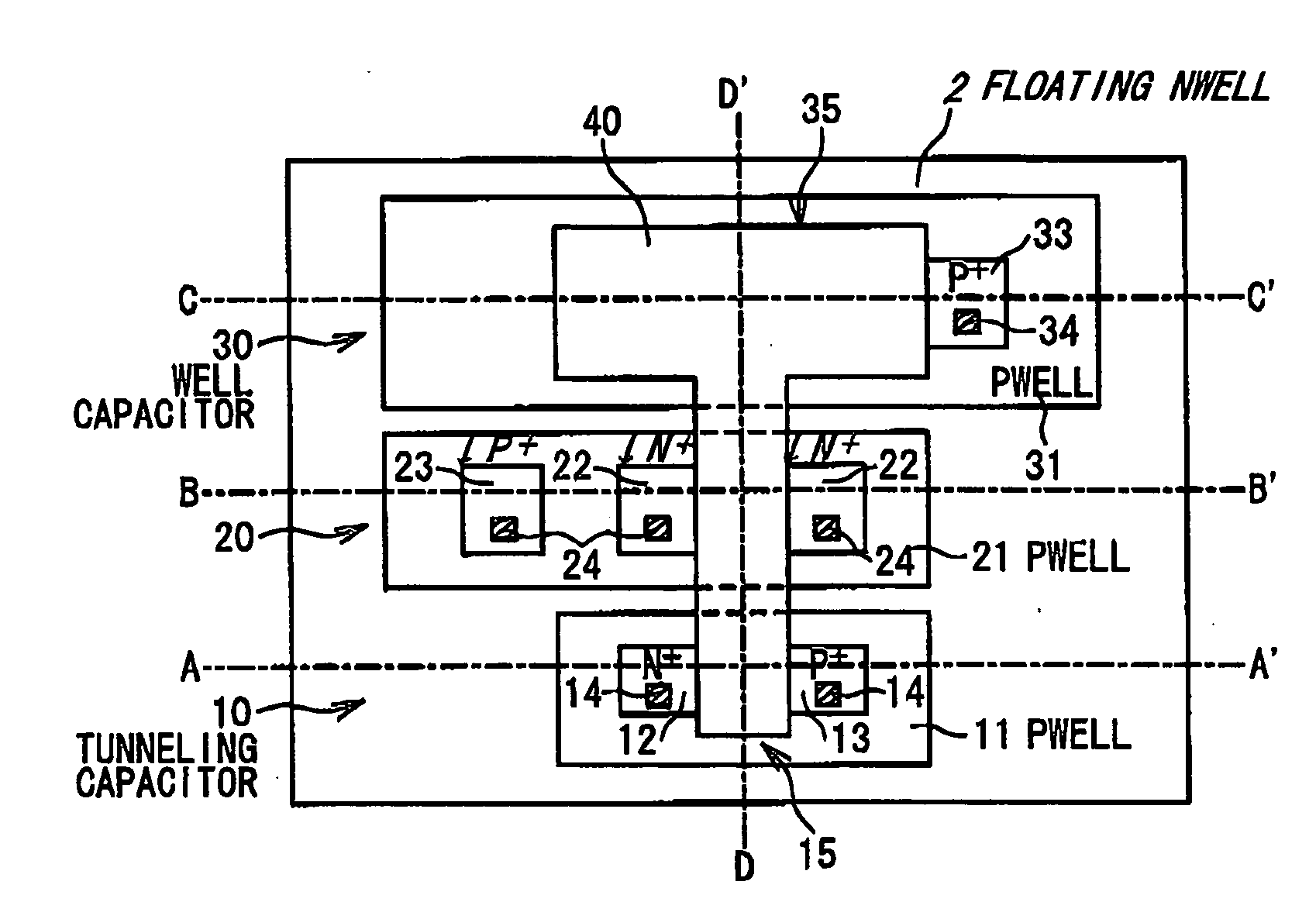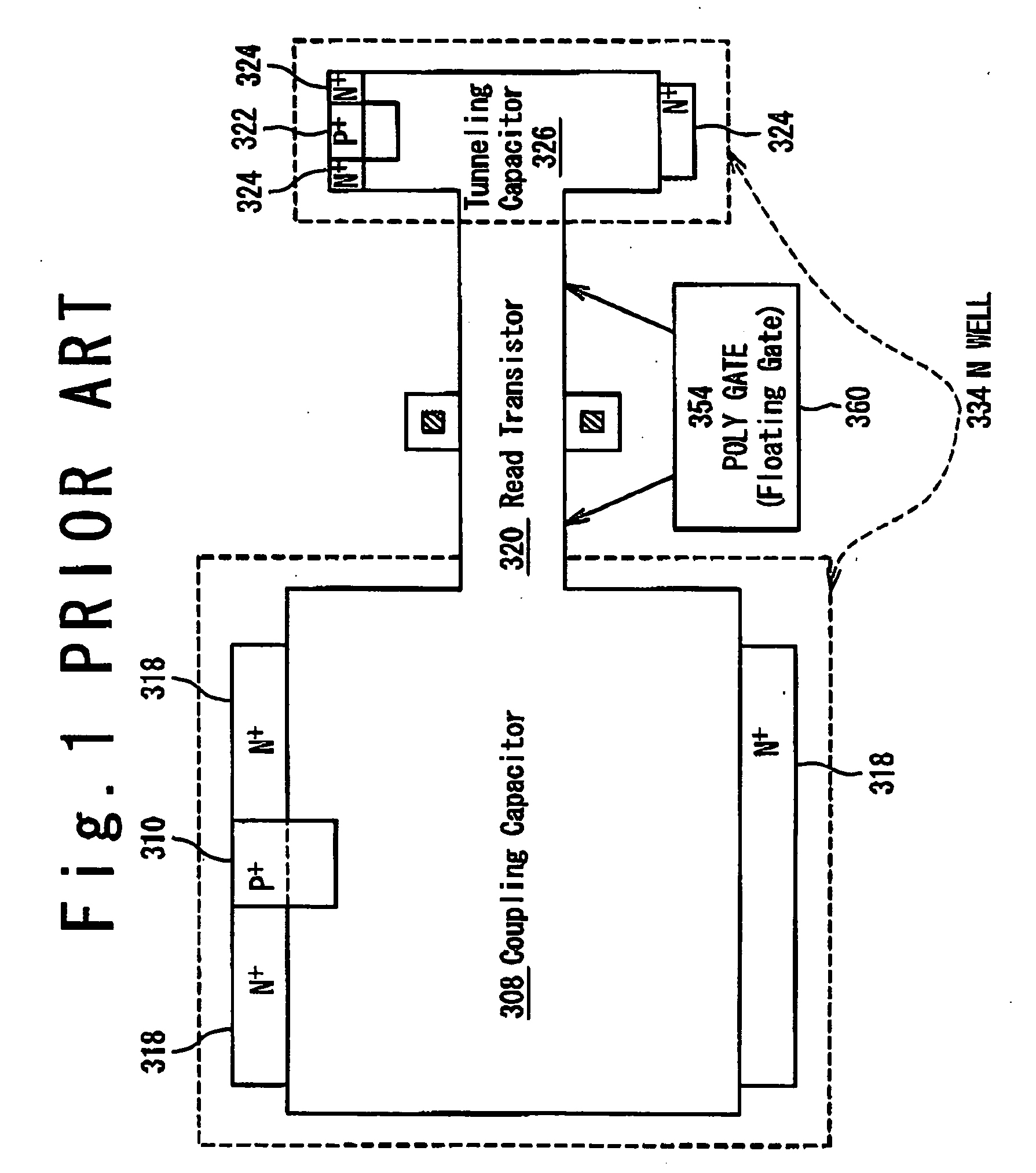Eeprom
a technology of eeprom and eeprom, which is applied in the direction of semiconductor devices, electrical apparatus, transistors, etc., can solve the problems of unbalance of charge supply efficiency and difference between a time required for programming, and achieve the effect of reducing the difference between the programming time and the erasing time, improving the supply efficiency of holes/electrons at the time of programming/erasing, and reducing the erasing tim
- Summary
- Abstract
- Description
- Claims
- Application Information
AI Technical Summary
Benefits of technology
Problems solved by technology
Method used
Image
Examples
first embodiment
1. First Embodiment
[0031] 1-1. Structure and Principle
[0032]FIG. 2 is a plan view showing a structure of the nonvolatile memory cell (EEPROM) according to a first embodiment of the present invention. Cross-sectional structures along a line A-A′, a line B-B′, a line C-C′ and a line D-D′ in FIG. 2 are illustrated in FIG. 3A, FIG. 3B, FIG. 3C and FIG. 3D, respectively.
[0033] As shown in FIG. 2, the nonvolatile memory cell according to the present embodiment has a tunneling capacitor 10, a read transistor 20 and a well capacitor 30. Furthermore, a floating gate 40 is provided with respect to the tunneling capacitor 10, the read transistor 20 and the well capacitor 30.
[0034] Referring to FIG. 2, the tunneling capacitor 10 is constituted by a P-well 11 and the floating gate 40. A region in which the floating gate 40 overlaps the P-well 11 is hereinafter referred to as a “tunneling region 15”. An N+ diffusion layer 12 and a P+ diffusion layer 13 are so formed in the P-well 11 as to cont...
second embodiment
2. Second Embodiment
[0057]FIG. 8 is a plan view showing a structure of a nonvolatile memory cell (EEPROM) according to a second embodiment of the present invention. In FIG. 8, the same reference numerals are given to the same components as those described in the first embodiment, and a redundant description will be appropriately omitted. The nonvolatile memory cell according to the second embodiment has the tunneling capacitor 10, the read transistor 20 and a well capacitor 30′. The configuration of the tunneling capacitor 10 is the same as that in the first embodiment. Therefore, the same effects as those in the first embodiment can be obtained.
[0058] In the present embodiment, not only the P+ diffusion layer 33 but also an N+ diffusion layer 32 is formed in the P-well 31 of the well capacitor 30′. The N+ diffusion layer 32 and the P+ diffusion layer 33 are so formed as to contact the overlap region 35 where the floating gate 40 overlaps the P-well 31.
[0059]FIG. 9 is a view corre...
third embodiment
3. Third Embodiment
[0066]FIG. 11 is a plan view showing a structure of a nonvolatile memory cell (EEPROM) according to a third embodiment of the present invention. In FIG. 11, the same reference numerals are given to the same components as those described in the first embodiment, and a redundant description will be appropriately omitted. The nonvolatile memory cell according to the third embodiment has two elements of the tunneling capacitor 10 and the read transistor 20. As compared with the foregoing embodiments, the well capacitor 30 is omitted.
[0067] In the present embodiment, the read transistor 20 serves as the well capacitor 30 in the first embodiment. That is to say, the read transistor 20 is used not only in the read operation but also in the programming / erasing operations. In the programming / erasing operations, a first potential is applied to the N+ diffusion layer 12 and the P+ diffusion layer 13 of the tunneling capacitor 10. Furthermore, a second potential is applied t...
PUM
 Login to View More
Login to View More Abstract
Description
Claims
Application Information
 Login to View More
Login to View More - R&D
- Intellectual Property
- Life Sciences
- Materials
- Tech Scout
- Unparalleled Data Quality
- Higher Quality Content
- 60% Fewer Hallucinations
Browse by: Latest US Patents, China's latest patents, Technical Efficacy Thesaurus, Application Domain, Technology Topic, Popular Technical Reports.
© 2025 PatSnap. All rights reserved.Legal|Privacy policy|Modern Slavery Act Transparency Statement|Sitemap|About US| Contact US: help@patsnap.com



